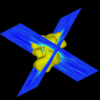News Archive
LBNL’s DataMover Reaches Milestone with Automated Transfer of 18,000 Files in a Single Request
Amidst the hype and hoopla at the recent SC2004 conference in Pittsburgh, Lawrence Berkeley National Laboratory’s Scientific Data Management Research Group demonstrated the robustness of the group’s DataMover by putting the application through its workaday paces. In doing so, the group reached a milestone when, with a single request, 17,870 data files were moved seamlessly from Brookhaven National Lab in New York to LBNL, both of which are operated by the U.S. Department of Energy. What… Read More »
Kathy Yelick Named Leader of BIPS, CRD’s Future Technologies Group
Kathy Yelick, a professor of computer science at UC Berkeley with a joint appointment in the Computational Research Division, has been named to lead for the newly established Berkeley Institute of Performance Studies (BIPS). She will also be leading CRD’s Future Technologies Group (FTG). Yelick’s appointment, which includes a leave of absence from her teaching position, officially takes effect Jan. 1, 2005.[image class="right"… Read More »
Crystallization in Silico
When Francis Crick and James Watson deciphered the structure of DNA in 1953, X-ray crystallography became famous; key to their success was crystallography of DNA done by Rosalind Franklin in the laboratory of Maurice Wilkins. X-ray crystallography has long since become the workhorse for structural studies of big biological molecules, including most of the many thousands of proteins whose structures have been solved in the last half century. Crystallizing biological molecules is… Read More »
LBNL Establishes Berkeley Institute for Performance Studies
Alan Laub, former director of DOE’s SciDAC program, once said that in the field of high performance computing, “peak performance” was defined as the speed at which “the manufacturer guarantees that you can’t compute faster than that.” Although peak performance figures make for good marketing, they don’t provide much insight into actual performance. To rectify this, for the past eight years Berkeley Lab has been developing new tools and techniques for more accurately… Read More »
LBNL to Highlight Leadership in Computational Science in Presentations, Demos at SC04
What kind of scientific breakthroughs can researchers achieve with one million dedicated processor hours on one of the worlds fastest supercomputers? Two million hours? Thanks to a special Department of Energy program, three research groups studying turbulence, astrophysics and chemistry were awarded a total of nearly 5 million hours on the 6,652-processor IBM supercomputer at the National Energy Research Scientific Computing Center (NERSC). Leaders of the three projects, supported under the… Read More »
LBNL’s Evaluation of Earth Simulator Performance Nominated for Best Paper Award at SC2004
With the re-emergence of viable vector computing systems such as the Earth Simulator and the Cray X1, there is renewed debate about which architecture is best suited for running large-scale scientific applications. In order to cut through the conflicting claims of fastest, biggest, etc., a team led by Lenny Oliker of the U.S. Department of Energy’s Lawrence Berkeley National Laboratory put five different systems through their paces, running four different scientific applications key to DOE… Read More »
ESnet to Increase Network Performance, Reliability with Metropolitan Area Networks
Responding to the increasingly data-intensive demands of the scientific community, the U.S. Department of Energy’s (DOE) Energy Sciences Network (ESnet) is implementing a new architecture of connected Metropolitan Area Networks (MAN). ESnet, which is managed by DOE’s Lawrence Berkeley National Laboratory, is a high-speed network serving thousands of DOE scientists and collaborators worldwide. A pioneer in providing high-bandwidth, reliable connections, ESnet enables researchers at national… Read More »
ACTS Collection Sponsors Fifth Annual Workshop
The 2004 DOE Advanced CompuTational Software (ACTS) Collection workshop was held Aug. 24-27 at Berkeley Lab. Read More »
LBNL’s Evaluation of Earth Simulator Performance Nominated for Best Paper Award at SC2004
With the re-emergence of viable vector computing systems such as the Earth Simulator and the Cray X1, there is renewed debate about which architecture is best suited for running large-scale scientific applications. In order to cut through the conflicting claims of fastest, biggest, etc., a team led by Lenny Oliker of CRD’s Future Technologies Group put five different systems through their paces, running four different scientific applications key to DOE research programs. As part of… Read More »
Cosmology Code’s Performance Characteristics Generates Paper
When the team from LBNL’s CRD and NERSC Divisions spent a week conducting performance evaluations of Japan’s Earth Simulator in late 2003, one of the five codes they intended to run did not scale well enough to be used. According to team leader Lenny Oliker, the application MADCAP (the Microwave Anisotropy Dataset Computational Analysis Package), a parallel implementation of cosmic microwave bacground map-making and power spectrum estimation algorithms, has been tuned since then… Read More »







 Instagram
Instagram YouTube
YouTube